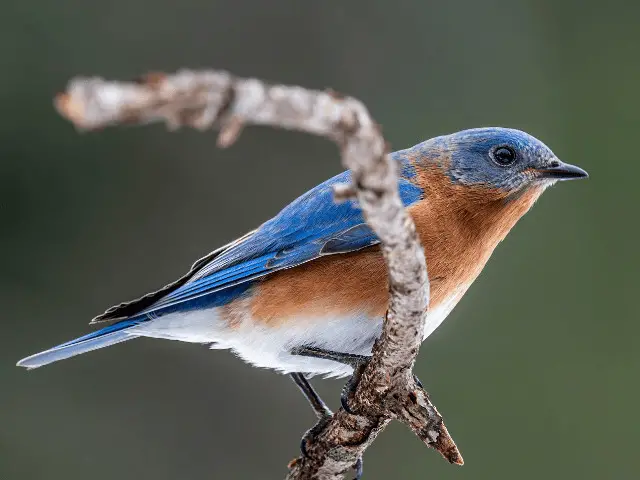Watching different birds provides a lifetime of knowledge of these creatures.
So...
If you're visiting Wisconsin for a day of satisfying birding experience, it's best to learn more about the various birds you can see there. That’s because, the state has abundant birdlife, which makes an exceptional appeal to birders worldwide.
But sometimes, bird watching can be challenging since several species look alike.
That’s why we provide you with relevant information in your pursuit of appreciating the diversity of the birds of Wisconsin. Knowing more about avian life will leave you with beautiful memories of a very enriching adventure.
Various Kinds Of Birds In Wisconsin
Green Bay's southern shore sometimes hosts an American white pelican breeding colony. Maybe you'll also come across summer residents within the grassy areas of Horicon without you knowing that you already did.
Improving your bird recognition skills helps you determine whether you see backyard birds or wild birds throughout the state. Wisconsin is an exceptional birding hotspot that provides countless opportunities to learn about different types of birds.
It involves and encourages citizens to study invasive bird species within the state to provide relevant information about the bird population.
So to help you maximize your birding experience in Wisconsin, you should know the several kinds of birds that you'll likely encounter there.
Here are some of them:
1. American Robin
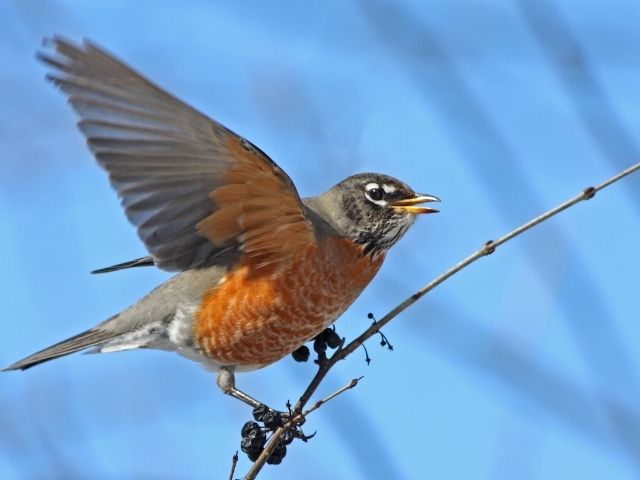
The American Robin is a medium-sized gray bird with dark rufous breasts and a yellow bill.
This bird's Canadian population partially migrates out of their breeding range, while those in the United States are primarily residents. A sight of this bird on your lawn will let you know it's already spring. Otherwise, this Wisconsin bird uses the support pole for perching.
Contrary to other species, this migratory bird has adapted and thrived well in human-modified environments. But what catches the majority of birders the most is this bird's egg in a beautiful blue. You will often see this creature in large flocks around October and November.
Additionally, breeding periods are long for this type of bird. This robin likewise builds nests in different locations due to variations in breeding habitat throughout the year.
2. House Finch
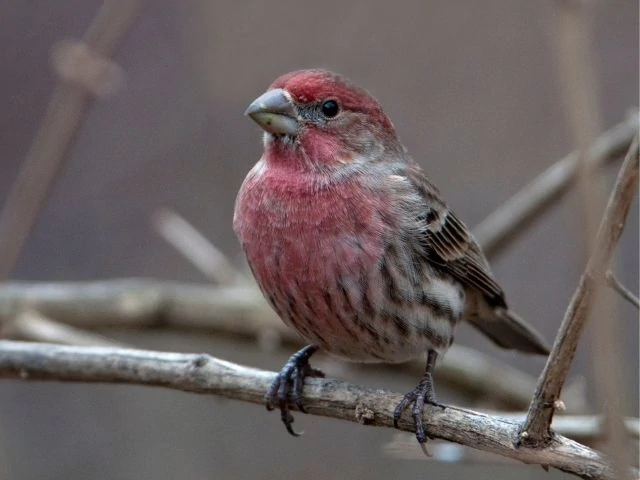
As an enthusiast of avian life, you can conveniently identify this perky-voiced bird through its appearance. It has bright red-orange upperparts, a white belly, and brown-streaked underparts. On the other hand, the female house finch has a plain-looking face with blurry streaks.
This bird has a loud and low-pitched song that catches the attention of even the non-birders. It lives in city parks and suburban neighborhoods, occasionally visiting bird feeders. Sometimes, you would see it in savannas and desert grasslands, feeding on buds, fruit, and seeds.
It is due to mycoplasma gallispeticum bacteria, which causes highly infectious conjunctivitis. The epidemic has led to finches' difficulty finding mates, making them an endangered species.
3. Mourning Dove
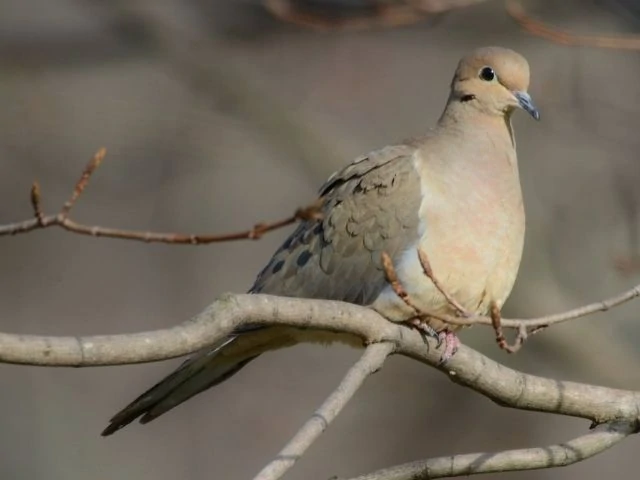
A close view and good lighting will allow you to appreciate how this dove is a thing of beauty. It has a small head, a slim grayish-tan body, a rosy breast, a long tail, and dark spots on its folded wings.
Although this dove has four subspecies with varying looks, two of which are widespread on the northern hemisphere continent. The larger of the two occurs somewhere east of the Mississippi River, and the smaller, paler one comes from the west.
However, a coopers hawk also loves visiting backyard feeders and preying on a mourning dove and other small birds. Besides that, this graceful bird is also well-known for being a native game bird, the most sought after during bird-hunting seasons.
Generally, this species inhabits suburbia, brushy areas, and farmland but prefers secure woodland during winter. It sometimes migrates when looking for food sources, naturally feeding on the ground, and can drink without raising its head like the rock pigeon.
4. Downy Woodpecker
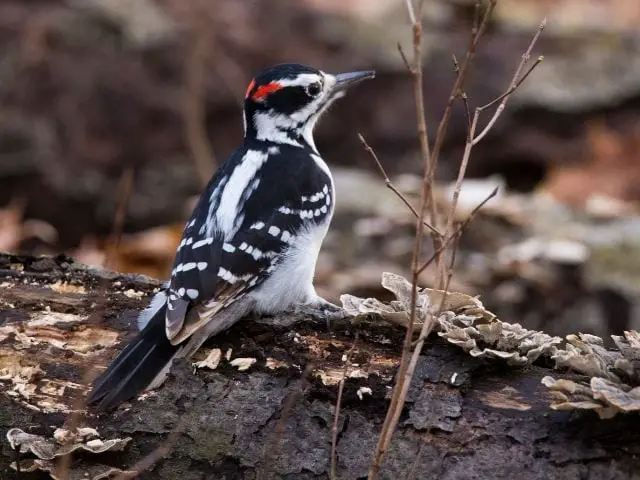
A little-known fact about this woodpecker is that it's the smallest of its kind in the North. The downy is even smaller compared with the nearly identical hairy woodpecker. The plumage of this diurnal bird is a combination of black, white, and red.
You can encounter this woodpecker mostly in backyards, fields, mountaintops, and woodlands. It is one of the backyard birds that prefer to eat suet from feeders.
The downy would sometimes join flocks of small-sized songbirds, like nuthatches, chickadees, and titmice when foraging. This bird also feeds on small branches and twigs besides suet.
5. Northern Cardinal
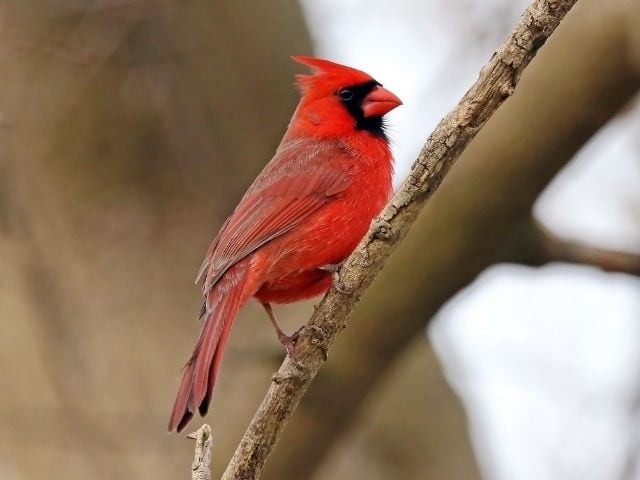
Identifying a bird based on its species or gender is another effective method.
A male cardinal has an overall red shade with a black patch on the face and a striking crest. While many birders see the female as dull-colored, it has a more intricate color scheme than the male.
The females have warm buff-brown underparts and tawny upperparts. Additionally, the female cardinals' wings and tails are outlined in reddish colors, while their crests are reddish.
Unlike an American goldfinch with changing plumages per season, olive-brown in winter and yellow in summer, this songbird keeps its bright shade throughout the year. This lovely creature is well-suited to various habitats, including an edge habitat, wetlands, and deserts.
In addition, it is one of the backyard birds in the state that eats black-oil sunflower seeds, peanuts, and suet. These birds won't even mind if you offer them mealworms. Planting fruit-bearing trees would also make your backyard irresistible to this familiar bird.
6. Blue Jay
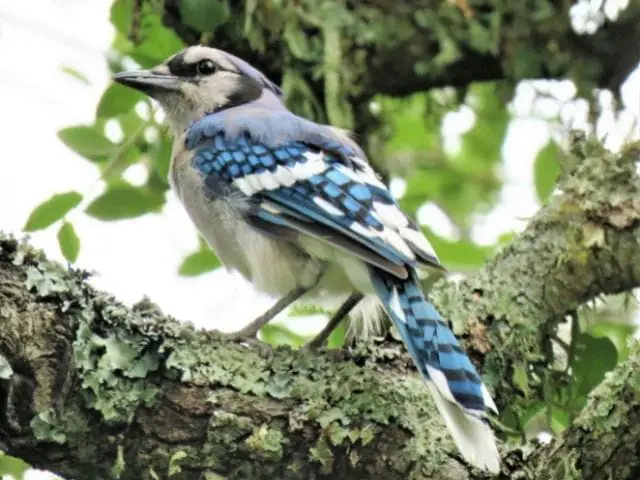
Despite the forest being its natural habitat, a blue jay is adept at acclimating to a vast range of environments.
Even though it doesn't frequently visit backyards, it only flies in once in a while for sunflower seeds. But despite that, this passerine bird is only a partial migrant and a year-round resident of the state.
Jays are Wisconsin birds attacking smaller birds, stealing their eggs, and taking over their nests. You will have no trouble recognizing this bird, as its plain blue mantle and some white spots on the wings and tail tips are pretty unmistakable. Additionally, both males and females look similar.
7. Black-Capped Chickadee
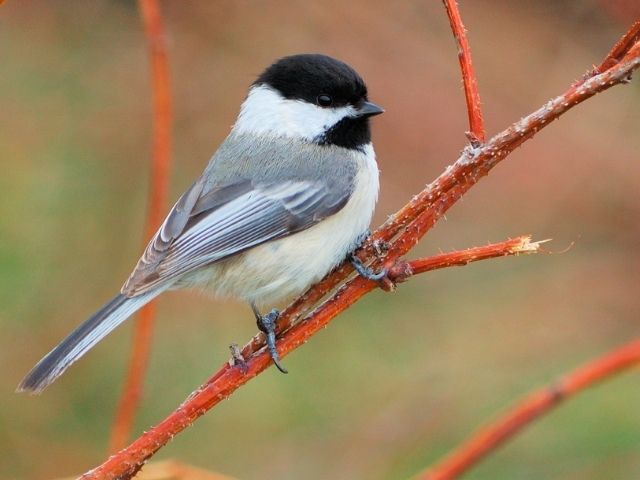
You might even encounter this chickadee as it dines in a suet cage with a downy woodpecker; their kind is tolerant of humans. This bird is readily recognizable with its light gray plumage with distinctive black and white streaks.
There is a chance you may confuse this bird with the Carolina chickadee if you have never seen it before. You can tell them apart by Carolina's smaller body size and with only a few white streaks on its wings.
8. Great Blue Heron
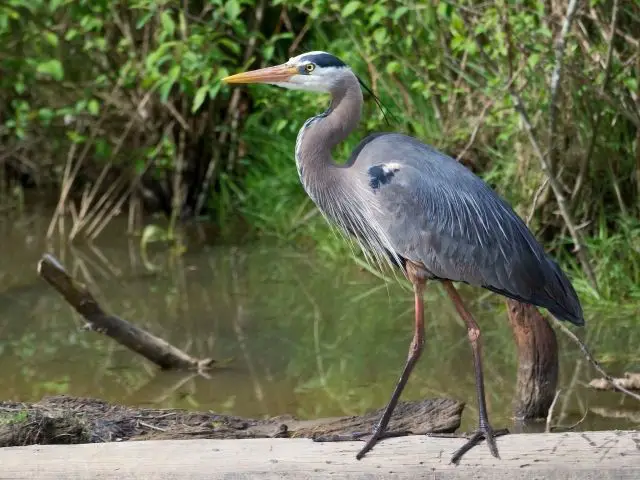
The great blue heron is a well-known wading bird you can spot in marshes and swamps throughout southern and central Wisconsin.
This majestic-looking bird is one of the most sizable herons worldwide that tends to outstretch its neck and extend its legs beyond the tail when flying. It is eye-catching with its gray-blue plumage, long yellow bill, and black-colored head stripe.
When hunting, you will notice this heron sweeping over marshes as it is a cunning feeder that catches prey with a thrust of its bill. Small birds and fishes, frogs, and ducklings are the heron's primary food sources.
9. House Sparrow
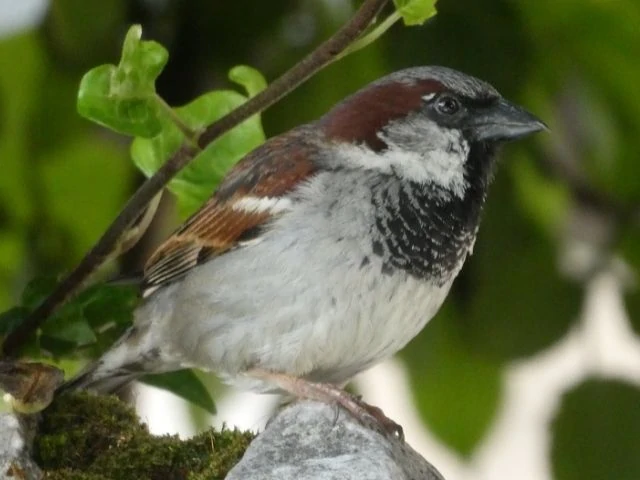
Its evolution resulted in geographic variation, paler birds in the dryer regions in the south, and dark-colored in damper regions.
You will notice this creature's slumped wings, upright tail, tilted head, and ruffled black bib and chest as part of its territorial display. It frequents urban feeders, although this bird is less desirable to many birders for its aggressive behavior that drives away other songbirds.
This bird is hostile toward rivals at feeders and nest sites, and you will often hear it chirping at night endlessly. It heavily feeds on sunflower seeds, cracked corn, and peanut bits.
10. Eastern Bluebird
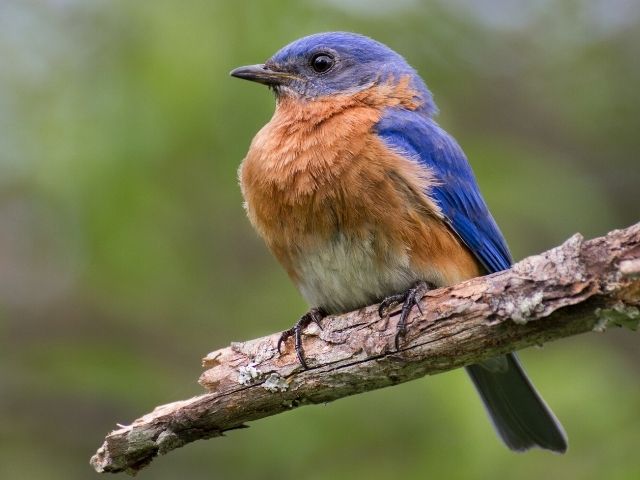
It's a lot easier to identify an Eastern bluebird by its color. You will readily notice the male's bright blue plumage with rust-red breast and the female's pale, mostly gray body, blue wings and tail, and chestnut-colored chest.
On the other hand, their fledglings have a gray-brown upper section and some spots in the throat and breast.
It shows a preference for wooden nest boxes in grassy pasturelands, orchards, old fields, and rural areas. This bird likes eating caterpillars and grasshoppers when breeding and feeding plants and fruits during winter.
While its population massively suffered from a severe decline due to habitat loss, you can help them by setting up birdhouses in your backyard.
11. Purple Finch
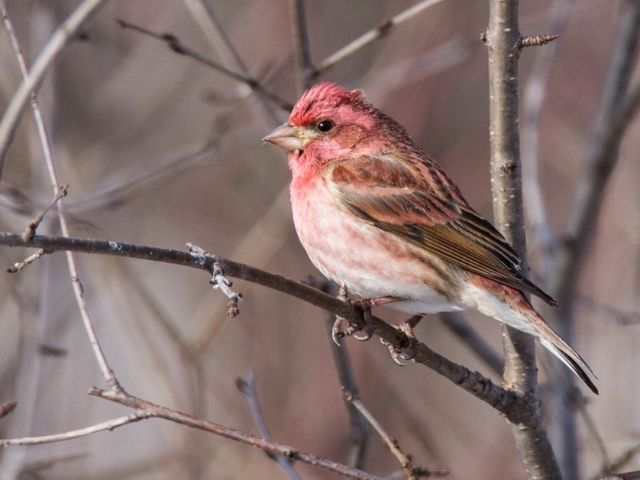
However, its kind keeps moving in flocks from one place to another when searching for food sources. The male is recognizable by its raspberry wash shade, brown cheek patch, gray bill, and pointed crown. It begins shedding in summer, and the male's reddish part appears frosted.
The female is a plain-looking brown bird with heavy streaks on the chest and a broad white stripe behind its eyes.
This finch typically lands on feeding stations in winter, so if you like to attract one in your garden, try having some native plants. It will also appreciate tube feeders full of thistle and black-oil sunflower seeds; likewise fond of fruits, seeds, blossoms, buds, and insects.
12. American Crow
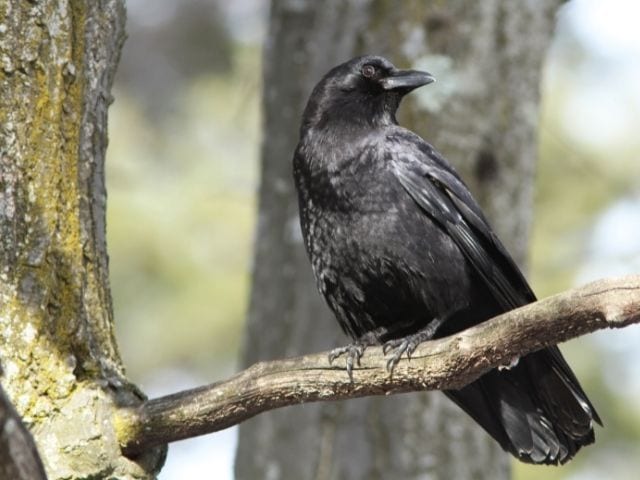
From the wildlife to urban areas, almost every habitat is home to the American crow.
Homesteads of this type of bird are expansive, as they are for most birds with immense ranges. This crow has a black plumage throughout the continent. However, the size and shape of their bills vary from one region to another.
You can tell this bird apart from a common raven by its purple luster when it's in direct sunlight. Common ravens also have wedge-shaped tails and gruff voices. In contrast, a crow's tail looks square or rounded with louder, almost nasal-like calls.
This creature is a fan of suet feeders, insects, fish, and fruits so it is easy to attract crows to your yard. It has the habit of mimicking human voices and flapping its wings nonstop when in flight.
13. Song Sparrow
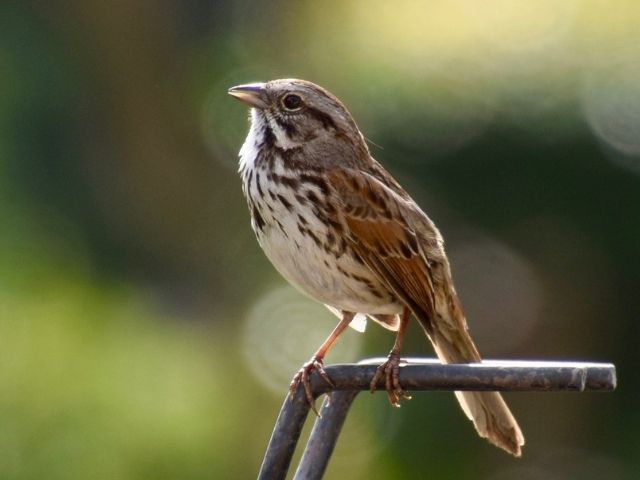
It has numerous subspecies; each of its kind can have colors ranging from faint gray, reddish, or dark brown. But one thing these birds could have in common is the spot at the core of their chests.
You can spot a song sparrow in brushy fields, cemeteries, parks, rivers, and woodlands. It rarely visits bird feeders like the other birds, but when it does, be sure that this sizable bird will look for peanuts, shelled or not.
This creature mainly feeds on the ground and likes insects, berries, seeds, and grasses. You can expect sparrows to nest in shrubberies along marshes, and males start singing their cheery notes during spring and summer.
14. Common Grackle

It has a long rudder-shaped tail with a bluish head, in addition to these features. The grackle is undoubtedly striking with its slightly purplish body, a thin bill, and golden eyes.
The female grackle looks similar except that it's smaller-sized with a dull-looking color and lacks the lovely iridescence. Moreover, you'll become aware of this creature's presence with its low-pitched bizarre squeaks and whistles.
It likes feeding on small vertebrates, flies, beetles, worms, and spiders; the bird's diet during the non-breeding season includes grains and seeds.
You can attract this gorgeous bird to your backyard feeders with sunflower hearts and cracked corn. But it can also be an opportunist, taking fledglings or eggs.
Frequently Asked Questions
What makes Wisconsin one of the best birding hotspots in the US?
Many refer to prairies as the wheat basket of North America, as much as Wisconsin also gets the recognition of being the North's duck factory. That came as no surprise since the state is rich with diverse habitats and natural resources that support the needs of many birds.
For this reason, Wisconsin is a favorite birding spot for many individuals. The Horicon National Wildlife Refuge, for instance, is one of the state's best birdwatching sites, gaining its reputation as the North's Everglades.
The Wisconsin Department of Natural Resources regulates this bird sanctuary, and it only gives birders limited access to the area to enhance wildlife protection.
Moreover, the Wisconsin Society for Ornithology is a nonprofit foundation encouraging bird conservation. It provides better opportunities for the state's birding community, like sponsoring birdwatching activities.
On top of all that, the American Bird Conservancy initiated Bird City Wisconsin to educate people on making every area a healthy bird habitat. The bird protection fund also supports the conservation of rare species by offering research scholarships.
What birds of prey can you find in Wisconsin?
There is no doubt that raptors are a popular animal species that grabs people's attention effortlessly. As you drive along Wisconsin highways during winter, you're likely to see birds of prey perched on power poles or hunting in roadways.
These birds could be year-round residents, while some are migratory. There are many of them, but here are only some of the birds of prey you can see in Wisconsin:
- Sharp shinned hawk
- Red tailed hawk
- Red shouldered hawk
- Northern goshawk
- American kestrel
- Great horned owl
- Eastern screech owl
- Peregrine falcon
Get to know more about Red Tailed Hawks in this video:
What is the International Migratory Bird Day?
This special event aims to increase awareness about the significance of migratory birds in our ecosystem. The event features games, activities, bird walks, and bird-banding demonstrations.
Wisconsin actively participates in celebrating the return of these migrating birds in spring. It aims to motivate individuals to contribute to improving bird welfare by sustaining wildlife and their habitats so they can continue watching them.
Some of these migratory birds in the state are the following:
- Ruby-throated hummingbird
- Broad-winged hawk
- Purple martin
- House wren
- Scarlet tanager
- Acadian flycatcher
- Rose-breasted grosbeak
- Yellow-headed blackbird
Final Thoughts
In summary, you already know what makes Wisconsin close to the hearts of many birders. Aside from Horicon Marsh and Green Bay providing a home to year-round residents, there's also the Wyalusing State Park.
There are breeding birds like the black-orange Baltimore oriole, red-shouldered hawk, and black-colored, red-crested pileated woodpecker in this 2,700-acre park. You can even see the bald eagle throughout the year along the Wisconsin River and the ospreys too.
Now, you'll never be clueless anymore about which places to go if you're in for a memorable birdwatching experience in Wisconsin. You only need your binoculars and a birding journal then you're already good to go.

